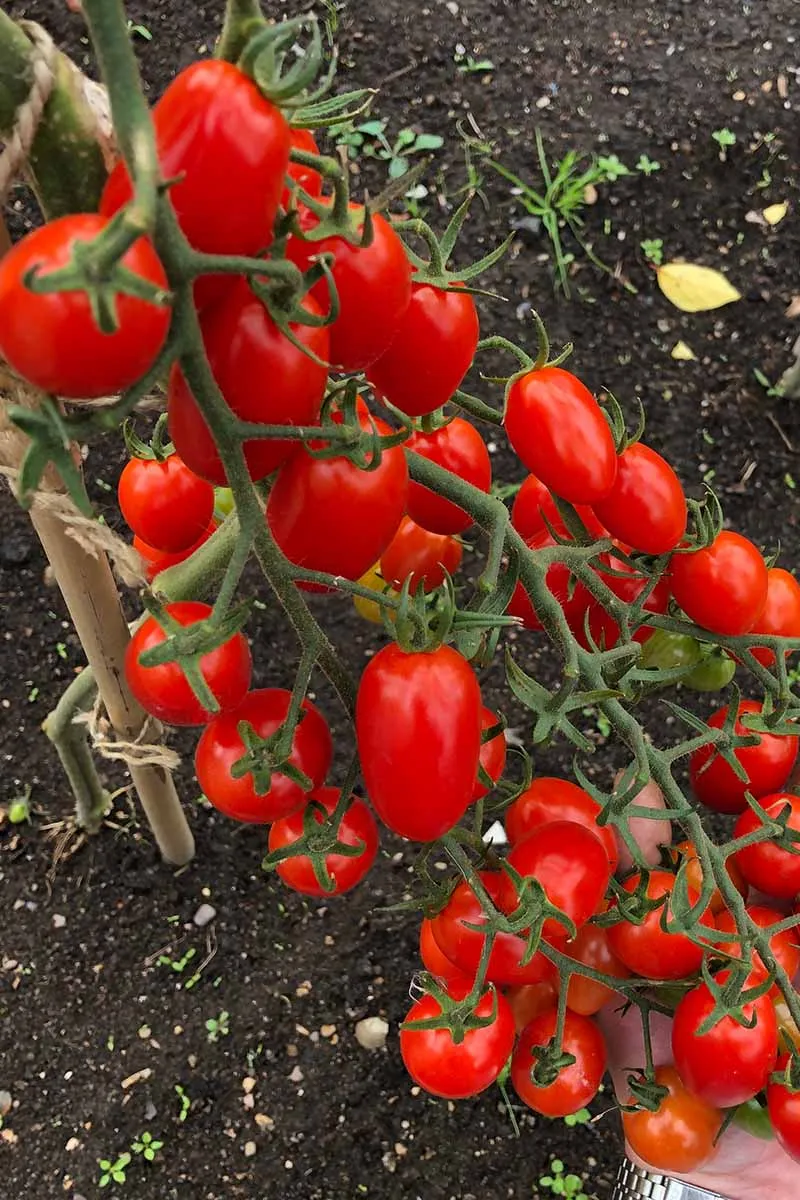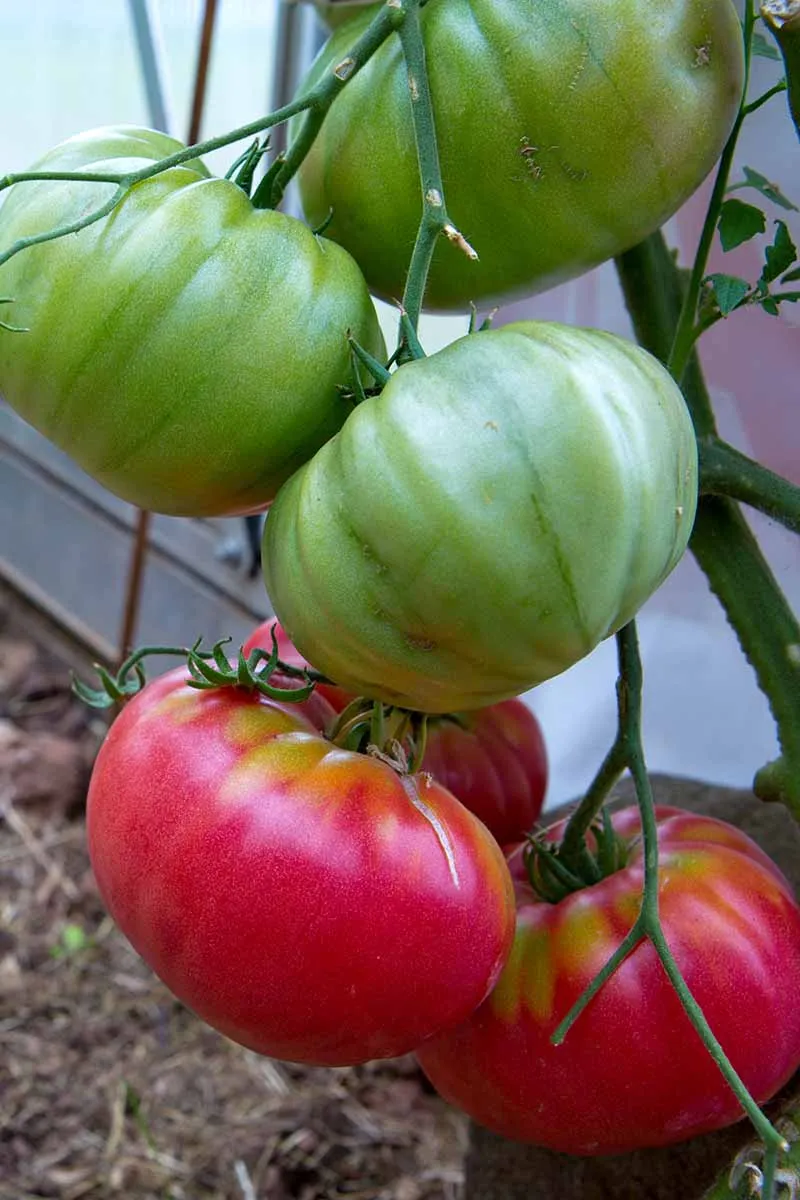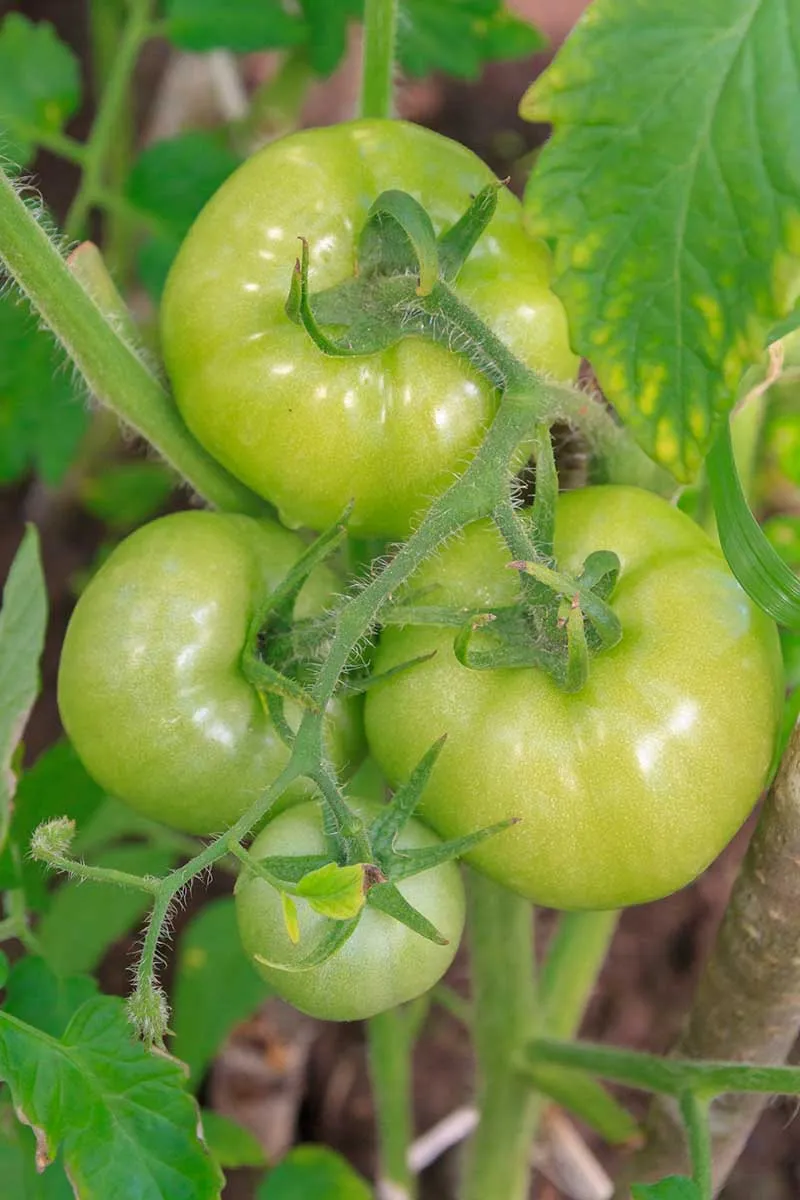How do I get tomatoes to turn red?

Are you seeing red? If you’re looking at your homegrown tomatoes, I hope they are a bright, cheery red color as they’re ripening on the vine.
Even experienced gardeners, I know, have moments when their plants are reaching the all-important harvest date and the fruit is still hard and green.
At any time in the growing season, but especially if a killing frost is bearing down, your stress increases by the minute. What should a gardener do?
I’m going to show you a few tricks for getting tomatoes to become red on the vine.
We link to vendors to help you find relevant products. We may get a compensation if you purchase via one of our links.
Some of my advice will only be useful when you return to the game the following season. Selecting your dream heirloom varieties and planting your crop.
There are, however, options for individuals who are in the “Ack! The tomatoes are turning green, and fall is approaching” camp.
And I’ll urge you to keep trying, even if it means picking every single green fruit. The cherry ones , and try to ripen them indoors.
After all, red tomatoes are both a visual and a culinary joy. It would be awful to tend your plants for the 70-100 days most take to produce ripe fruit and then come up short at the end of the season.
These are the aspects that I’ll cover:
Contents
Why Are Ripe Tomatoes Commonly Red?
If your plants are producing fruit that isn’t a vivid crimson, it’s comforting to know that lots of gardeners have that complaint. We all want red tomatoes, after all!
But have you ever wondered why these fresh tomatoes that we home gardeners find so appealing are red?
There’s a scientific reason, and understanding it may assist you with your own fruits that refuse to turn red when you want them to.

Chlorophyll is responsible for the green color of the fruits. When they progress from maturity to ripening, they produce a naturally-occurring hormone called ethylene.
The ethylene triggers the ripening process, causing the fruit to become red and soften.
In terms of timing, most tomato plants need around three weeks from transplant to reach flowering height, which ranges from 12 to 18 inches for most varieties.
If all goes properly, it will usually yield green fruit that will mature in 20 to 30 days.
After they’ve reached full size, they’ll take another 20 to 30 days to mature and change color from green to yellow to red.

From flower to harvest, cherry and grape types may typically yield small, juicy, red fruit in 25-30 days.
If you do the arithmetic and that isn’t what’s occurring in your garden, it’s time to perform some additional detective work to figure out why your crops aren’t maturing on the vine.
4 Reasons Your Tomatoes Won’t Ripen on the Vine
You can’t take this phenomena personally, as I learned from experience on more than one occasion when my vines stubbornly held on to hard, green fruit.
Instead, inspect your plants and garden to determine if any of the following four variables are interfering with their capacity to mature into a rich red:
1. Temperatures Are Too Warm
If your tomatoes seem to be stuck on green while it’s still warm outside, heat might be the culprit.
It’s hard to believe this about such easy-to-grow garden vegetables, but they can be a bit temperature sensitive. Temperature, like ethylene, determines when the pigment begins to change.
The ideal temperature for tomatoes to become red is between 68 and 77 degrees Fahrenheit. A little warmer is okay, but when temperatures exceed 85-90°F, the ripening process grinds to a halt, or at least slows down.
If the temperature is too warm, your fruits may look either greenish orange or pale green on the vine, to the point of being almost white. But not in red.
Fortunately, there is good news:
If it’s just too hot for the pigments to develop, you’ll have plenty of time in the growth season to adjust to the slowness.
2. Temperatures Are Too Cool
On the flip side, cooler weather can also put a stop to those desired changes that will turn your crops a rosy shade. Again, you’re looking for an ideal temperature range of 68-77°F for them to mature to a bright red shade.
If the temperature drops below 55°F, add a week or two to the average time it would take the fruit to mature if the temperature was 65°F, based on your seed packets or plant tags.
What to do if the weather should get cooler still?
If your location has overnight temperatures below 50°F and daytime temperatures below 60°F for two weeks or longer, the transition to that wonderful red tint you’re seeking will come to a stop.
When the temperature drops below 50°F, your plants will not produce fruit. You might get some green fruits if your plants are trying to set fruit in 50-55°F weather, but count on them to also develop odd shapes and soft spots.

The way to getting those with green fruits through a cold spell is simple:
Protect the plants with row cover , an old bed sheet, or even a plastic tarp.
When a tomato plant is exposed to cold conditions, all hope for the green fruits and the plants themselves is lost. Regrettably, no fruit will be salvageable at that time.
If the cold weather isn’t going away, or if trustworthy sources anticipate frost, you may still harvest the fruit that’s already on your plants. You may be able to bring any that have started to soften or change color on the interior to ripen.
I’ll include techniques for keeping green tomatoes before a frost and turning them red inside later in this article.
Yet it is your final option. Before this takes place, review the possible reasons why your fruits aren’t ripening on the vine, and try to solve these issues before frost arrives.
3. Wrong Variety for Your Growing Season
If you’re producing what you thought would be delicious red tomatoes but they’re still green, and frost is on the way, you may have picked an unsuitable variety for your climate.
When you live in a place where there’s a short growing season It’s critical to choose short-season cultivars so that the green fruit has enough time to mature and become red before temperatures fall below 50°F.
Among the finest short-season types are ‘Early Girl,’ which bears ripe, red fruit approximately 50 days after transplant, and ‘Juliet,’ a red grape cultivar that matures about 60 days after transplant.
Even a reputable local nursery may sometimes carry seedlings of a variety that will not bear ripe fruit consistently before the first frost in your region.
When you purchase transplants, investigate how long your selected cultivars will take to develop, and do the same if you’re planning to obtain seeds or plants from a trustworthy supplier.
4. Stressed or Overgrown Vines
Tomato plants, like all living things, have a finite amount of energy. If they’re using too much to grow leaves and flowers, they may not have any energy left to turn green fruit red.
To prevent this from happening to your vines, some trimming should be done six weeks before the first forecast frost in your location.
Trim your vines with scissors or shears, trimming them down to the point where the stems are carrying ripe green fruit.
This aids ripening in two ways:
- It prevents the plant from further flowering, wasting important energy.
- It promotes ventilation, which might help to keep fruits and plants fresh. infected with disease .
You may also try cutting the roots of your plants to encourage those green fruits to become crimson.
Doing this is pretty straightforward:
You cut the roots below the earth using a shovel, approximately one foot away from the main stem of each plant.
At four or five areas around the plant, cut about 6 inches into the dirt. This should sever the roots in those spots, which can prevent the plant from growing taller and blossoming, and instead turn its energies to ripening the existing fruit.
When You Should Compost Green Tomatoes
This is one of the many reasons why I love growing my own fruits and vegetables. So much good may come from this, even from stuff that is not harvested.
A good example is green tomatoes. If you’ve chosen a variety that won’t ripen on the vine in time, or an unexpected bout of chilly weather strikes late in the growing season, you can still get some value from the green fruit by adding them to your compost pile.
No, it’s not as satisfying as sitting down to a harvest of vine-ripened, homegrown produce. Nevertheless it’s reassuring to know that your efforts still resulted in some beneficial compost components.
Where do you draw the line between green tomatoes on the vine that may be matured inside and those that should be composted?
Any green ones that are still hard should be thrown on the pile or thrown away. You only want to spend the time and energy on indoor ripening if it’s what us gardeners call “mature green.”
Look for a shiny green surface and gently squeeze the tomato. It should be at least a little soft and maybe streaked with a bit of yellow, indicating that ripening has begun on the vine.
If they are hard and have a flat, matte green hue, it’s time to give up and compost them for next year’s planting.
This goes double for green grape or cherry varieties This will not ripen on the vine. No amount of nurturing indoors will make them turn red, and they’re lots of trouble to pick individually and bring indoors.
And skip the heroic measures for any unripe fruits that are marred or misshapen. They’ll shrivel inside and would do lot better in the compost.
If you don’t already have a compost pile or bin, tomatoes that don’t turn red provide an excellent chance to begin this environmentally good practice.
How to Ripen Green Tomatoes Indoors
I’m not going to lie. When you have to resort to trying to make your unripe harvest turn red indoors, you’re not going to get the same great taste as you would with vine-ripened homegrown fruit.
For one thing, while you can make them ripen a bit indoors, you can’t make it produce the sugars that make homegrown tomatoes taste so great. You may urge your green crop to create more ethylene, but this does not result in sugar production.

Nonetheless, if you have “mature green” tomatoes on your vines, it’s worth a try. Don’t anticipate delicious, dripping slicers, but do expect red fruit that tastes much superior to commercial varieties.
Instead of eating them in a caprese salad, you’ll probably prefer them in homemade salsa, atop tacos, or boiled into soups.
Are you growing your plants in containers ? The simplest way to try to turn those red is to bring the whole potted plant indoors, where it’s warmer.
You may even uproot whole vines full of mature green fruit and hang them upside down from rafters in the garage or basement until the fruits are red and ripe if you have the room and the strength.

Make sure some of the roots are still connected, then hang the vines in a well-lit but not direct-sun location.
Make sure the temperature is continuously in the 50-70°F range wherever you relocate your potted or uprooted plants.
You may also pluck them separately and store them inside to ripen. If you set them on a countertop, they’ll eventually produce enough ethylene to turn red and to soften.
If you get impatient, you can also set them in a bag with a ripe tomato to speed up their ethylene production. When you add a piece of banana or apple to the mix, it emits ethylene gas, which accelerates the ripening process even faster.
You’ll have to be vigilant, though, and remove each one that turns red as it ripens. Otherwise, rotten fruit will ooze over the still-hard green fruit. (I saw this firsthand.)
And, whatever you do, fight the urge to store your ripening tomatoes in the refrigerator. They need to turn red at room temperature, or they’ll lose every bit of their tomatoey flavor.
Love Is Like a Red, Red Tomato
When you go to all that trouble to cultivate your own beautiful tomatoes, it’s only right that they’re a lovely, eye-appealing red when it’s time to harvest.
However, if you didn’t have time to make a last-minute attempt to color your crop red on the vine, there’s always next year
It’s never too early to consider about the finest red tomato varieties for your region, or to start planning your garden for a red crop when next year’s plants mature.
If you have a tale of a crop that refuses to mature on the vine, please share it in the comments area below, along with any questions you may have.
Related Questions
-
Why my tomatoes are not turning red?
As temperatures rise over 85 to 90 degrees Fahrenheit, the ripening process slows or even stops. Lycopene and carotene, the pigments responsible for the fruit’s characteristic orange to red color, cannot be synthesized at these temperatures. As a consequence, the fruit may remain in a mature green phase for an extended period of time.
-
Will picked green tomatoes turn red?
Tomatoes, like many other fruits, continue to ripen after they’ve been plucked. Ethylene is a gas that fruits, especially tomatoes, emit to encourage ripening. Many commercial tomatoes are actually picked while still green for shipping and ripened at their destination by introducing them to an ethylene-rich environment.
-
Can you pick green tomatoes and let them ripen?
Green tomatoes may be ripened inside as long as they are maintained at normal temperature. Tomatoes start the ripening process on the vine and continue to ripen after they’ve been picked because they produce a gas called ethylene.
-
How do you force green tomatoes to turn red?
Put a few green tomatoes in a paper bag, seal it, and keep in a warm place to ripen. By enclosing tomatoes together, the ethylene they generate will encourage ripening. You can add a ripe banana or apple as well to speed things up. When a tomato is ripe, take it out of the bag and eat it immediately away.





